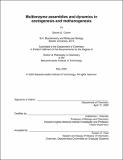| dc.contributor.advisor | Catherine L. Drennan. | en_US |
| dc.contributor.author | Cohen, Steven E.,Ph. D.Massachusetts Institute of Technology. | en_US |
| dc.contributor.other | Massachusetts Institute of Technology. Department of Chemistry. | en_US |
| dc.date.accessioned | 2020-09-15T21:56:56Z | |
| dc.date.available | 2020-09-15T21:56:56Z | |
| dc.date.copyright | 2020 | en_US |
| dc.date.issued | 2020 | en_US |
| dc.identifier.uri | https://hdl.handle.net/1721.1/127421 | |
| dc.description | Thesis: Ph. D., Massachusetts Institute of Technology, Department of Chemistry, May, 2020 | en_US |
| dc.description | Cataloged from the official PDF of thesis. Vita. | en_US |
| dc.description | Includes bibliographical references. | en_US |
| dc.description.abstract | The Wood-Ljungdahl pathway of acetogenesis allows for growth utilizing carbon dioxide as the sole carbon source. This process uses a series of metalloenzymes to catalyze the reduction of two molecules of carbon dioxide to acetyl-CoA. Key to this pathway are the bifunctional carbon monoxide dehydrogenase/acetyl-CoA synthase (CODH/ACS) and corrinoid iron-sulfur protein (CFeSP). CODH/ACS is a bifunctional enzyme, with the CODH subunit catalyzing the reduction of carbon dioxide to carbon monoxide. CFeSP is a cobalt-containing corrinoid-dependent methyltransferase. The active site of ACS, termed the A-cluster, is a nickel, iron, and sulfur-containing metallocluster which catalyzes the synthesis of acetyl-CoA from carbon monoxide provided by CODH, a methyl group provided by CFeSP, and CoA. Despite the unprecedented organometallic chemistry performed at the A-cluster much is unknown about this ACS activity. No substrate-bound structures of ACS have ever been reported and the molecular basis for ACS and CFeSP interactions are largely uncharacterized. Here we present the structure of the carbonylated A-cluster in CODH/ACS, highlighting the role of conformational dynamics in catalysis. We further characterize ACS dynamics using negative-stain electron microscopy, demonstrating a much larger extent of conformational flexibility than has been crystallographically observed. The basis for CFeSP:ACS interactions is further interrogated using a series of CFeSP domain constructs, showing the corrinoidbinding Rossmann fold to be sufficient for ACS interactions. Finally, we report preliminary structural characterization of acetyl-CoA decarbonylase/synthase (ACDS), a 2.2 MDa complex of CODH, ACS, and CFeSP found in archaeal methanogens. Together, this advances our understanding of the roles of structure and dynamics in the Wood-Ljungdahl pathway. | en_US |
| dc.description.statementofresponsibility | by Steven E. Cohen. | en_US |
| dc.format.extent | 148 pages | en_US |
| dc.language.iso | eng | en_US |
| dc.publisher | Massachusetts Institute of Technology | en_US |
| dc.rights | MIT theses may be protected by copyright. Please reuse MIT thesis content according to the MIT Libraries Permissions Policy, which is available through the URL provided. | en_US |
| dc.rights.uri | http://dspace.mit.edu/handle/1721.1/7582 | en_US |
| dc.subject | Chemistry. | en_US |
| dc.title | Multienzyme assemblies and dynamics in acetogenesis and methanogenesis | en_US |
| dc.type | Thesis | en_US |
| dc.description.degree | Ph. D. | en_US |
| dc.contributor.department | Massachusetts Institute of Technology. Department of Chemistry | en_US |
| dc.identifier.oclc | 1192923877 | en_US |
| dc.description.collection | Ph.D. Massachusetts Institute of Technology, Department of Chemistry | en_US |
| dspace.imported | 2020-09-15T21:56:56Z | en_US |
| mit.thesis.degree | Doctoral | en_US |
| mit.thesis.department | Chem | en_US |
